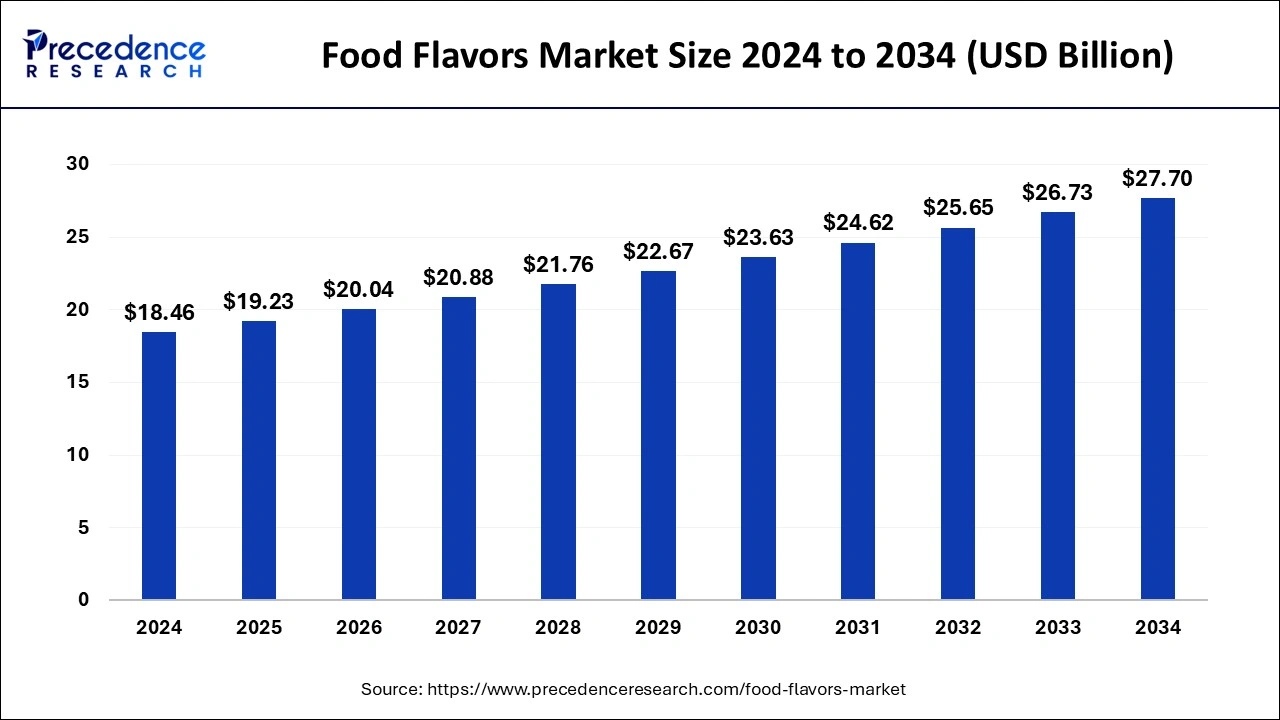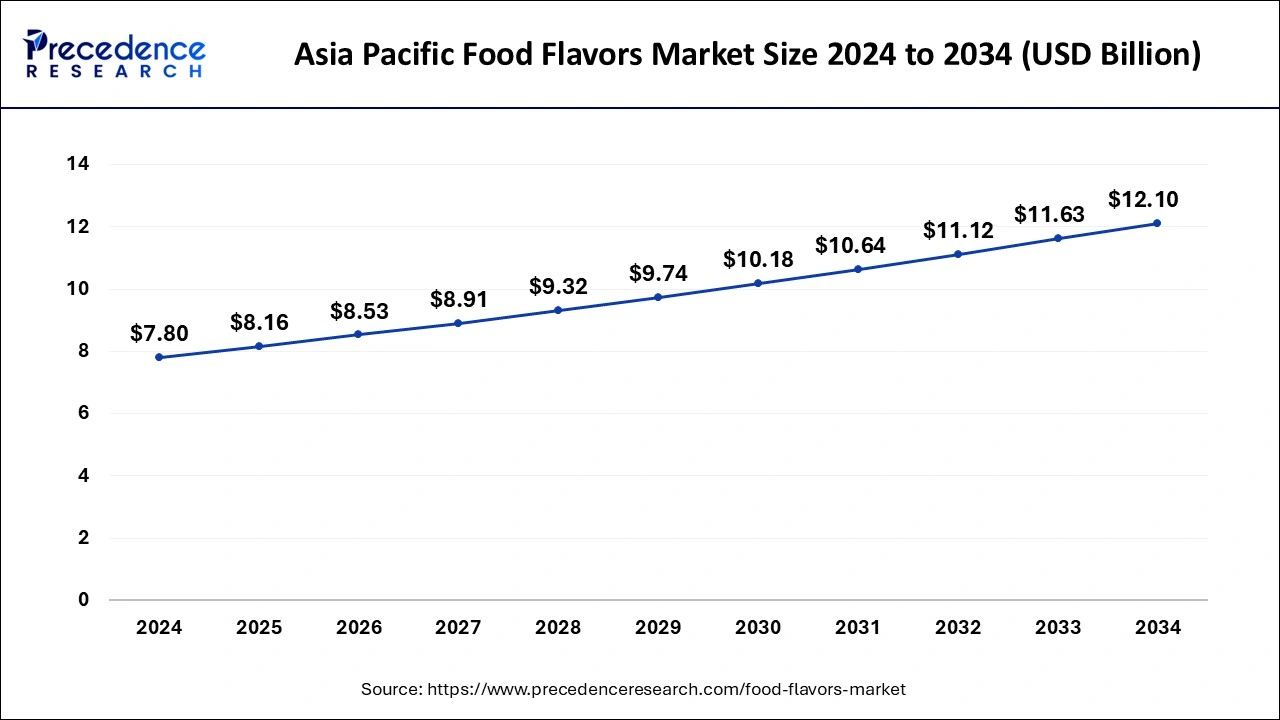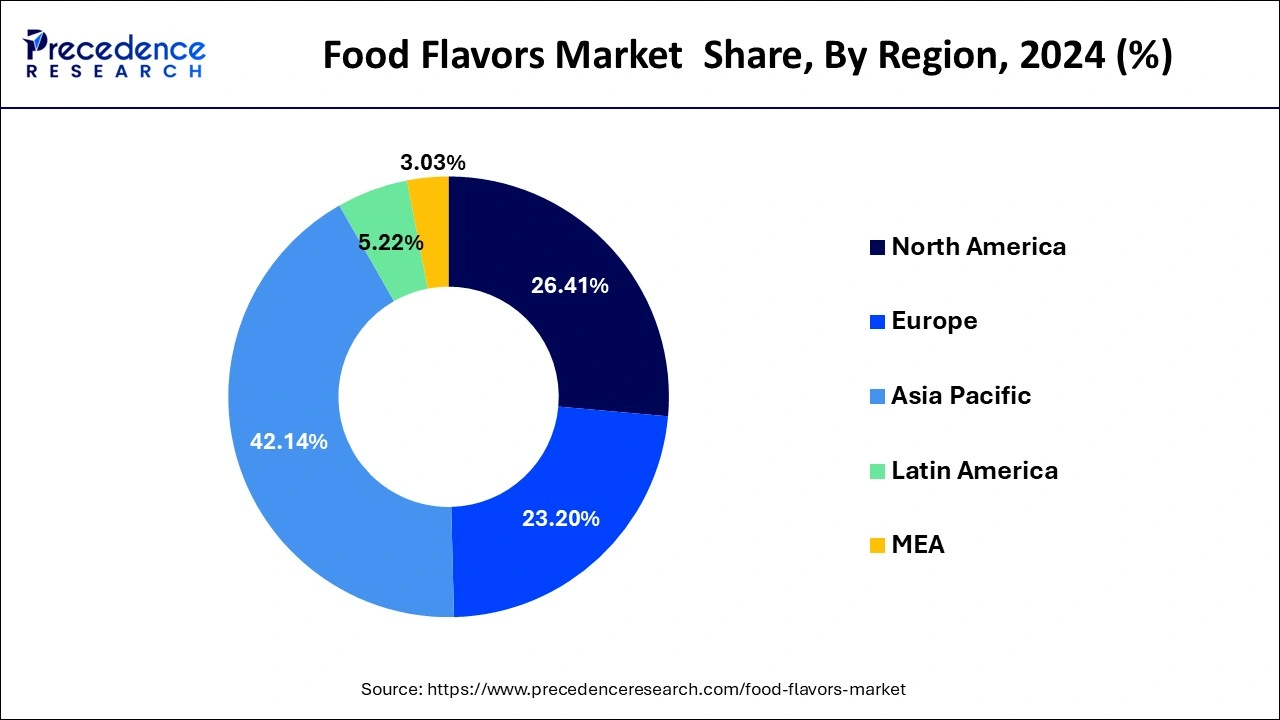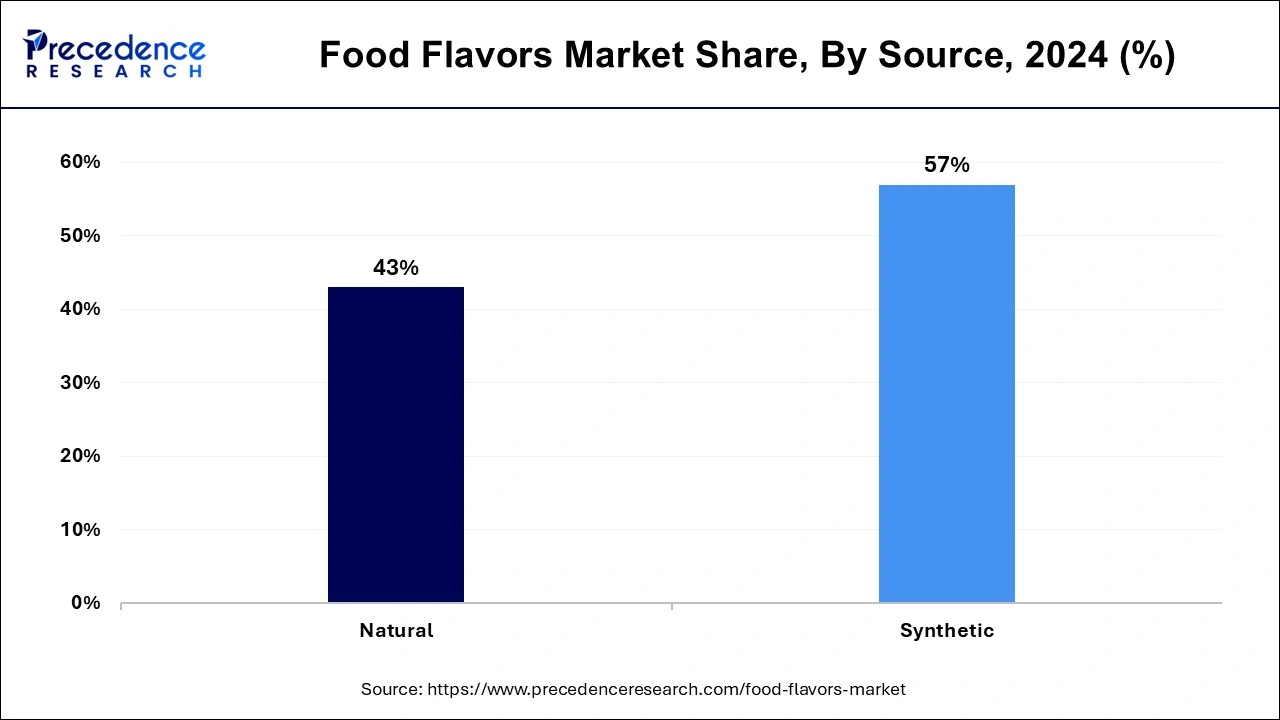January 2025
The global food flavors market size is calculated at USD 19.23 billion in 2025 and is forecasted to reach around USD 27.70 billion by 2034, accelerating at a CAGR of 4.14% from 2025 to 2034. The Asia Pacific food flavors market size surpassed USD 8.16 billion in 2025 and is expanding at a CAGR of 4.49% during the forecast period. The market sizing and forecasts are revenue-based (USD Million/Billion), with 2024 as the base year.
The global food flavors market size was estimated at USD 18.46 billion in 2024 and is anticipated to reach around USD 27.70 billion by 2034, expanding at a CAGR of 4.14% from 2025 to 2034. The food flavors market is driven by the rising demand for natural and clean-label ingredients.

AI detects many datasets to forecast food quality, safety, and shelf life. These models aid in analyzing production processes, lessening waste, and improving product quality by detecting factors that impact food properties and recommending adjustments to production parameters. AI image recognition can investigate, and sort food products based on quality attributes like size, shape, and color. These systems help automate quality control and ensure help in product quality.
The Asia Pacific food flavors market size was estimated at USD 7.80 billion in 2024 and is predicted to be worth around USD 12.10 billion by 2034, at a CAGR of 4.49% from 2025 to 2034.

The highest market share and dominant position in the food flavors industry belongs to Asia-Pacific due to the increased demand for innovative and improved food items. The high production and sales of the food and beverage industry, the rising purchasing power of the general public, and the growing presence of significant players in the region is driving the food flavor market in the region. Moreover, the market for food flavors in the Asia Pacific region is expanding quickly as a result of the region's high consumption of processed foods and beverages. The Asia Pacific region has a developing economy and a sizable working-class population. One of the key macroeconomic variables supporting the market growth for eatable flavoring agents is population trends. Additionally, chances for numerous mid-tier businesses would be created by investments from various multinationals, particularly from important countries like China, India, and Japan. The use of various ready-to-eat/drink goods is influenced by the growing population of working women and a hectic lifestyle. Additionally, it is anticipated that the region's consumption of baked goods and confectionary items will have a very high growth potential.

North America is considered as second-largest region in the consumption of food flavors. This is due to the region's consumption of numerous regional cuisines. Due to the region's migratory population, authentic food products are consumed there, which has prompted the creation of numerous international edible services. American consumers enjoy Indian and Japanese cuisine. Japanese dishes and ingredients like matcha, sushi, and ramen are very popular, which attracts both stores and eateries. Japanese food uses a variety of flavors, including umami. Umami is a flavor that prolongs the flavor of whole foods in Japanese cooking. This significantly contributes to the expansion of this market in North America.
Food flavors are frequently added to food products to enhance their flavor. The primary flavor additives are synthetic and natural flavors. After processing and preserving, perishable foods have a tendency to lose their flavor over time, necessitating the application of flavoring agents to help preserve the flavor. The food and beverage sector needs flavors for a variety of reasons, including the development of new products, the addition of new product lines, and the modification of existing products' flavors.
The rising consumption of various packaged eatable items and beverages is a primary driver of the global industry. All packaged consumables contain flavoring agents among other food additives. The consumption of ready-to-eat food products is popular due to the fast-paced lifestyle and rising number of working women. The market for food flavors will rise as a result of this. Natural food consumption is on the rise, and the food business is constantly looking for novel flavoring ingredients. Players in the food flavor sector have a ton of potential because of these natural flavoring ingredients.
| Report Coverage | Details |
| Market Size in 2025 | USD 19.23 Billion |
| Market Size by 2034 | USD 27.70 Billion |
| Growth Rate from 2025 to 2034 | CAGR of 4.14% |
| Base Year | 2024 |
| Forecast Period | 2025 to 2034 |
| Segments Covered | By Source, By Application, and By Form |
| Regions Covered | North America, Europe, Asia-Pacific, Latin America, and Middle East & Africa |
Depending upon the origin, the natural segment is the dominant player and is anticipated to have the biggest impact on food flavors. The rising demand for food products that promote wellness and health is a major driver of the global market for natural food flavors. The market for natural food flavors is expected to grow as a result of a number of factors, including the health benefits of some natural colors and flavors, rising purchasing power among consumers, a rise in the demand for organic food products, and a wide variety of products with novel tastes and flavors.

Moreover, many food establishments use the organic flavors to produce real flavor. Additionally, the younger generation prefers to cook with a range of botanicals and adaptogens. This is due to a greater awareness of the detrimental effects of synthetic flavors. Ingredients in artificial flavorings have been linked to cancer and a host of other health issues over time. Many businesses manufacture natural food flavorings because the innovative use of raw materials supplied from organic farms offers the food industry considerable possibilities.
The enormous demand for artificial tastes in fast food, packaged meals, and ready-to-eat items also contributes to the expansion of this market.
During the projected period, the beverage segment is anticipated to be the largest in the food flavors market. Due to rising discretionary budgets among consumers, various synthetic flavors, including chocolate fruit and floral flavors, are growing in popularity in developing economies in Asia Pacific and the Middle East. Over the forecast period, the dairy, confectionery, and bread sectors are anticipated to increase significantly. Numerous flavors, including fruit flavors and natural spices, are frequently used in dairy beverages and other dairy products. It is projected that the market would rise because to the rising popularity of cocoa and fruit tastes in the bread and confectionery industries.
Apple, banana, mango, grapes, pineapple, pomegranate, berries and citrus fruits are just a few examples of the many fruits that are highly popular. They are then transformed into syrups and fruit extracts, which are then added to different foods and beverages to change or enhance flavor, aroma, or color. Hence, these applications are driving the beverage segment.
By Source
By Application
By Form
By Geography
For inquiries regarding discounts, bulk purchases, or customization requests, please contact us at sales@precedenceresearch.com
No cookie-cutter, only authentic analysis – take the 1st step to become a Precedence Research client
January 2025
January 2025
September 2024
January 2025